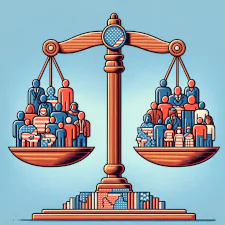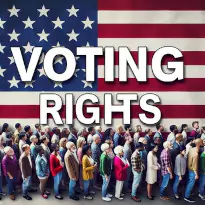The Voting Rights Act of 1975 Amendments were significant updates to the original Voting Rights Act of 1965, a crucial piece of civil rights legislation in the United States. These amendments, enacted on August 6, 1975, expanded the scope of the original Act to address voting discrimination against language minority citizens, including Hispanic, Asian, Alaskan Native, and Native American populations. Key aspects of the 1975 amendments include:
What is the Voting Rights Act 1975 Amendments?
- Bilingual Election Requirements: The amendments required jurisdictions with significant populations of citizens who were limited English proficient to provide bilingual voting materials and assistance. This requirement was designed to ensure that all citizens could participate effectively in the voting process, regardless of their English language proficiency.
- Extension of the Act’s Special Provisions: The 1975 amendments extended the special provisions of the Act, such as the preclearance requirement under Section 5, for seven years. This meant that certain jurisdictions with histories of voting discrimination had to continue seeking federal approval before making changes to their voting laws or practices.
- Expansion of Coverage: The amendments expanded the coverage formula to include jurisdictions that had a single-language minority population exceeding five percent of the voting-age citizens. These jurisdictions were required to provide language assistance in voting.
- Strengthening Enforcement: The amendments enhanced the federal government’s ability to enforce the Act’s provisions, especially in areas where language minorities were at risk of being disenfranchised.
These amendments represented a significant step in addressing the evolving challenges faced by minority voters, particularly in terms of language barriers, and demonstrated a continued commitment to ensuring equal access to the voting process for all American citizens.
Table of Contents
- The Original Voting Rights Act: A Quick Recap
- Why Changes to the Voting Rights Act Was Necessary
- The Impact of the 1975 Amendments:
- Representation of Minorities in Government: New Faces, New Voices
- Controversies and Challenges Surrounding the 1975 Amendments
- Later Developments and Reauthorizations of the Act
- When Courts Stir the Pot: Supreme Court Decisions That Shook Things Up
- The Legacy of the 1975 Amendments Today: Echoes from History
- Future Implications: What’s Next on this Long Road?
- The Power and Progression of the Voting Rights Act Amendments of 1975
The Original Voting Rights Act: A Quick Recap
We go back to August 6, 1965. That’s when President Johnson signed the Voting Rights Act (VRA). This law stopped racial discrimination in voting across the U.S. The VRA targeted unfair election rules like literacy tests.
These were used mainly in the South against African Americans. The VRA used the Fourteenth and Fifteenth Amendments. It aimed to make voting fair for everyone. The law removed racial barriers to voting. It made sure every vote counted, no matter the person’s race or ethnicity.
Why Changes to the Voting Rights Act Was Necessary
After celebrating the VRA’s first success, we see its flaws. The VRA didn’t fix all voting issues. It stopped clear discrimination like literacy tests and poll taxes. Yet, subtle biases remained. Gerrymandering still weakened minority votes. English-only materials also limited non-English speakers. The 1975 Amendments tried to fix these issues. They aimed to make voting more equal and inclusive.
An Unprecedented Leap: Extending the Special Provisions

The saying goes, “Rome wasn’t built in a day.” Securing voting rights in America was similar. The 1965 Voting Rights Act was a start. In 1975, Congress had to work more on it. The new Act did more than just rewrite the old one.
It extended key parts from five to seven years. This might seem minor, but it was important. Section four stopped literacy tests in areas with low voting. Section five required federal approval for voting changes in these areas. By extending this, Congress showed its dedication to equal voting access.
Breaking Language Barriers: Creating an Inclusive Democracy
Congress did more in 1975. They helped language minority groups. This was a big step in removing communication barriers. The law focused on areas with single-language minorities. These people needed help with English in voting.
Now, bilingual materials are required by law. Imagine being a new voter from Mexico or Vietnam, confused by English. Before 1975, understanding voting materials was tough. It could stop you from voting. The 1975 changes brought bilingual guides to polling stations. This made voting easier for many. It empowered them to vote and be heard.
The Impact of the 1975 Amendments:
A Revolution Quietly Unfolding
The 1975 Voting Rights Act Amendments were crucial. They focused on language and minority protection. This act did more than just update an existing law. It changed the political scene in big ways. These changes didn’t just affect laws.
They changed people’s lives. The impact reached individuals, families, and communities. Let’s look at the key points of these amendments.
- Extended special provisions.
- Introduced language minority protections.
- Focused on minority representation in government.
These changes were huge. They brought in new voters and representatives. This reshaped politics significantly.
Voter Registration Numbers: Counting More Heads at the Polls

After 1975, minority voter registration rose significantly. The amendments removed language barriers for non-English speakers. This led to more participation and fair representation at polls. We have solid data on this.
The U.S. Commission on Civil Rights reported big increases. Hispanic voter registration jumped from 34% to 70% by 1988.
Other non-English speaking groups also saw big gains. This change marked a new, inclusive democracy. It wasn’t just about the numbers and means.
- Empowerment
- Representation
- Active involvement in national decisions.
It gave marginalized groups a voice at the table. The amendments played a key role in this progress.
Representation of Minorities in Government: New Faces, New Voices
A Subtle Shift Towards Diversity

The 1975 amendments also boosted minority representation in government. Before, U.S. government representation was mostly uniform. It didn’t reflect America’s diverse society. The act helped fix this. It allowed more minorities to participate in local politics.
This included school boards, city councils, and county governments. This led to higher political roles over time.
A key example is Hispanic representation in Congress. It grew from 3 members to 19 by 1991. This isn’t fully proportional to their population yet.
But it’s a big improvement from the past. These changes brought new voices to Capitol Hill. They also brought new perspectives to policy-making.
Controversies and Challenges Surrounding the 1975 Amendments
When Lawmakers Become Lawbreakers: Legal Battles and Court Decisions
Every law, even with good intentions, can cause conflict. The 1975 Voting Rights Act Amendments did just that. They led to legal battles that still affect voting rights today. A major conflict involved Texas, ironically a state that influenced the language provisions.
In 1976, Texas faced a lawsuit for not implementing bilingual ballots. This lawsuit was a big win for voting rights supporters. But it also sparked opposition from various groups. Surprisingly, even in Congress, there were efforts to hinder these amendments.
Many places used delay tactics or ignored the law. Each time this happened, it led to more court cases. These cases reaffirmed the amendments’ constitutionality and importance.
Not Everyone’s Cup Of Tea: Public Opinion and Political Backlash
You can’t please everyone all the time, and laws are the same. The 1975 Amendments faced backlash beyond legal and political realms. They stirred up public debate too. Some saw these changes as federal overreach. They thought states should handle these issues.
This opinion stems from the long-standing states’ rights debate in U.S. history. Another criticism was that these amendments favored some minorities over others. Some groups felt ignored while others got special treatment. This sparked intense debates, showing the challenge of balancing interests in a diverse society.
A subtler backlash was apathy or indifference. Many were either unaffected or disillusioned with politics. This attitude raises questions about engaging citizens more in democracy. Every controversy with the 1975 Amendments deepened our voting rights conversation. It pushed us to challenge old views and work for a fairer, more inclusive democracy.
Later Developments and Reauthorizations of the Act
Why Time Stands Still for No Law: Updates in ’82, ’92, and ’06
Laws, like gardens, need care to stay useful. The Voting Rights Act is a good example. It has evolved with society. In 1982, the Act changed significantly. It strengthened protections against voting discrimination.
The change was in the burden of proof. Now, jurisdictions had to prove their laws weren’t discriminatory. This was a big shift from citizens proving discrimination. In 1992, the Act changed again.
This time, it focused on the “results test.” It meant laws that reduced minority voting power could breach the Act, even without intent to discriminate.
The most recent update was in 2006. The Senate unanimously extended key parts for another 25 years. But this extension sparked debates. Some questioned if special provisions were still needed, given progress towards equality.
When Courts Stir the Pot: Supreme Court Decisions That Shook Things Up
In 2013, Shelby County v Holder was a key Supreme Court case. It greatly impacted voting rights. The court struck down two parts of the Voting Rights Act.
These were Sections 4b and 5. They required places with discrimination histories to get federal approval before changing voting laws.
This mostly affected Southern states. Chief Justice Roberts wrote the majority opinion. He said these sections were based on old data. He argued they went against state sovereignty and equality. This ruling ended the need for federal pre-clearance. It raised fears of new voter suppression efforts.
After the ruling, many states passed restrictive voting laws. These laws often affected minority voters more. Critics said Shelby County v Holder weakened the Voting Rights Act. They called for new laws to restore its strength.
The Legacy of the 1975 Amendments Today: Echoes from History
Current State of Voting Rights: Are We There Yet?
Today’s voting rights situation is a mix of progress and old challenges. The 1975 Voting Rights Act Amendments made a big impact. But there’s still work to do for full voting rights. Take voter ID laws, for example.
They’re meant to stop voter fraud. But critics say they hit minorities and lower-income groups hardest. These groups often lack the needed IDs. This situation is like the old literacy tests and poll taxes. It’s a new version of an old problem.
Gerrymandering is another ongoing issue. It’s when electoral boundaries are changed for political gain. This problem has a long history. Court rulings on racially motivated redistricting vary. This leaves minority voters at risk. Their voices can be weakened or silenced.
Future Implications: What’s Next on this Long Road?
The future of voting rights is full of challenges and chances for improvement. One big step forward could be automated voter registration nationwide. This could add millions of voters. It would also tackle issues like registration deadlines and errors. Fair redistricting is another key area. It would help make sure every vote counts equally, regardless of race or wealth.
It’s important to remember our successes too. Since 1975, there’s been more diversity in elected offices. This is largely thanks to the amendments. It’s a sign of hope. It shows that, despite the long journey, we’re moving towards something better.
The Power and Progression of the Voting Rights Act Amendments of 1975
On our journey, we’ve delved deep into the 1975 Voting Rights Act Amendments. We looked at their deep impact and the debates they sparked. These amendments are key in history. They refined and boosted the original act’s goals. Making sure language minorities had voting rights. They also extended crucial parts of the act.
These changes were more than just words on paper. They echoed in power corridors and daily life. They helped create a fairer setup for democracy. These amendments brought real changes to people’s lives. They opened new opportunities and amplified diverse voices in our democracy.
The story of voting rights is ongoing. The 1975 Amendments didn’t solve all issues of inequality. Progress has been made, but challenges remain. The fight for fair elections continues. The Shelby County v Holder case shows how fragile progress is. Yet, it also reminds us of our achievements.
The conversation about voter suppression is ongoing. But the Voting Rights Act has shown its resilience. As we face new challenges and opportunities, one thing is clear. Democracy is a journey towards better representation and inclusivity. The 1975 Amendments are a reminder of our past. They show our progress and the path still ahead.
This story isn’t finished. It evolves with each vote, voice, and step toward fair elections. We all have a role in shaping this narrative. History shows that change is possible with persistence and bravery. Let’s continue the legacy of this law. Together, we can build an even more inclusive democracy!

